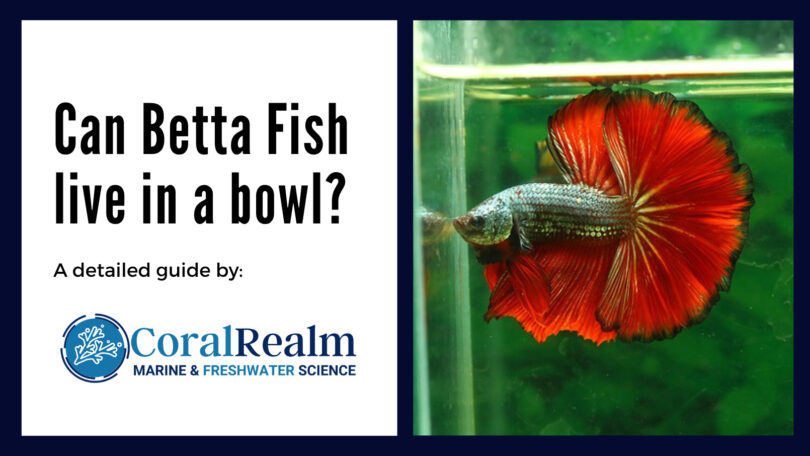Last Updated on February 13, 2023 by Jakob
Betta fish are a popular fish for newbies; males are solitary creatures and require little space, but can Betta fish live in a bowl? What is safe for a beta fish exactly? By bowl, we mean the most basic living quarters for a fish, a good old fashioned goldfish bowl. We’ll address all these questions below.
First of all, there’s some things to consider when you consider keeping Betta fish in a bowl: Betta fish are tropical fish. They are native to South East Asia and favor the shallow waters of rice fields, canals, still pools of water and small wild lakes. These bodies of water are incredibly warm. Do you think the warm rice fields of South East Asia are comparable to a plain fish bowl?
 Let’s start with the obvious, of course a Betta fish can survive in a bowl. It’s tempting to want to keep them here, as most bowls on the market now are ‘artsy’ and ‘chic’, and can be placed in various areas around the house. They are testaments to design more than they are dedicated to the health of fish. But it’s not that simple, there’s also other factors at play; sunlight and aqua fauna like marimo moss balls present in the bowl can determine what is and is not suitable. A bi-orb type bowl or a small box with a Hang on the back filter, heater, plenty of substrate, a natural plant base and LED lights is much more different to a regular bowl and variations thereof in-between. If you are using a bio-orb bowl, the answer should be obvious (yes it is suitable). For example, while we wouldn’t consider putting a betta in the bowl to the left, it’s much better than a plain one.
Let’s start with the obvious, of course a Betta fish can survive in a bowl. It’s tempting to want to keep them here, as most bowls on the market now are ‘artsy’ and ‘chic’, and can be placed in various areas around the house. They are testaments to design more than they are dedicated to the health of fish. But it’s not that simple, there’s also other factors at play; sunlight and aqua fauna like marimo moss balls present in the bowl can determine what is and is not suitable. A bi-orb type bowl or a small box with a Hang on the back filter, heater, plenty of substrate, a natural plant base and LED lights is much more different to a regular bowl and variations thereof in-between. If you are using a bio-orb bowl, the answer should be obvious (yes it is suitable). For example, while we wouldn’t consider putting a betta in the bowl to the left, it’s much better than a plain one.
In general, it is not ideal to keep Betta fish in a bowl. Most bowls don’t have adequate filtration and will quickly become a toxic environment for the fish – large volume water changes can shock fragile Betta fish and send them into a bad immune response. In short, basic bowls on their own lack the natural nitrogen cycle environment to keep fish healthy. I’m sure your fish will survive in a basic bowl, but if we’re into fish keeping – isn’t the goal for the fish to thrive and to be happy?
The best size tank for a Betta fish is 5 gallons (around 20 liters), you might think these fish don’t need much room – but that doesn’t mean they’re going to be happy in a small space.

IN THIS ARTICLE
10 Reasons why a Betta Fish should not be in a Bowl
There are 10 main reasons why we can’t recommend it – the simply answer: just buy a small fish tank that you have pride in, the betta won’t be happy in a tiny space with limited water quality.
1. High risk of toxic water quality
This is the most important reason to not keep Betta fish in a bowl. The most common fish bowls are less than a gallon in size. Small bodies of stagnant water (water with no fresh source) go bad very quickly, especially water with living things in it. Accumulations of fish waste (see how often to feed a betta fish), a lack of an efficient nitrogen cycle, no fresh flow and no water stir means low oxygen levels, and levels of ammonia will go sky high.
The larger the bowl the longer this process will take before levels reach immediate toxicity for the fish. But unless you change the water, all this does is buy you time. You’d have to delicately change 30% of the water in one go, and that is a pain in the long term.
Betta fish bowls are unstable environments for this reason. Placing the bowl in sunlight, by a heater, AC or even a window can greatly impact the temperature of the water; because the volume is so low. Even though Betta fish are hardy creatures, their natural environment doesn’t include drastic temperature change.
Since most fish bowls are small, doing large volume water changes will shock the fish, and for that reason, this is the most important reason why it’s not ideal to keep Betta fish in a bowl.
2. Fish Bowls do not have filters
Most fish bowls don’t come with water filters, and this is partly down to the size of the bowl. There simply isn’t enough room, and if you do install a filter it’ll be very disturbing to the fish in such a small space.
If you do decide to install a small filter into the bowl, this will make it a much more suitable environment for the fish. It’ll need to be small, and we recommend these filters for fish bowls.
However, even though filters can be purchased for a bowl, it’s often more practical to purchase micro tanks as getting the filter and electricity supply over the top of the bowl can be unpractical and unsightly.
3. Fish Bowls are cold, and your Betta Fish is Tropical
Yes, contrary to popular belief Betta fish are tropical fish. Betta fish 75–80 degrees Fahrenheit (or 23.5 to 27 degrees Celcius) and we have even written about the needs of temperature requirements of Betta fish, it’s so important.
You’ll need to have a a heater in the bowl to provide the optimal environment for a Betta fish, which presents problems in its own right. For example most fish bowl heaters are still quite large and thereby take up already limited space, not only that, you have to be careful that it doesn’t hit the aquarium substrate or other aquarium decor. If the heater does do that then you’ll be looking at a burnt out heater. You also have to make sure it isn’t outside the water, see more at how to install an aquarium heater.
If you live in a hot climate and don’t use the AC obsessively, then the Betta fish should be ok. However, we’re trying to create an environment where the fish is happy, and though they can technically survive in colder water, that doesn’t mean it’ll thrive.
4. Betta Fish thrive better in high oxygenated water.
This is slightly misleading as Betta fish originate from Brackish water, and our Marine Biologist author, Chris, has seen them in their natural environment. Despite that, just because they can survive in harsh environments, it goes without saying that if you take away a harsh environment then the fish does better. There’s a reason that fish (well looked after) live longer in captivity than in the wild.
The main way for a Betta fish to consume oxygen is through a labyrinth organ – translating to taking in oxygen the same way we do – directly from the air. But betta fish will still prefer to have a good water oxygen supply.
In order to add that oxygen, a filter that disturbs the surface of the water will suffice, or specialized oxygenator (these are quite common nowadays).
5. We think Siamese Fish in Bowls look awful:

Although some bowls are artsy, there’s nothing better than a thriving ecosystem providing a great visual and habitat for your betta fish.
A bowl on its own with a betta fish in it? Well we think it looks awful – don’t you?
6. Plants don’t do well in bowls
Plants are an essential for fish tanks, they purify water, provide shelter and shade.
But plants, like fish, require care and bowls have a small body of water (which isn’t good for plants) aren’t able to allow plants to thrive either. Plants need substrates, good water and sometimes specialist LED lighting.
Since you can’t place a bowl in direct sunlight, you’ll be limited where you can place a bowl in a place with natural light.
7. Betta Fish Bowls have little room for substrate
Because of the spherical shape of a bowl, there’s less volume at the bottom of the bowl than rectangular fish tanks where the volume at the bottom is consistent. So there’s little room for aquarium substrate.
Substrate is important because, like in the real world ecosystems, it provides: natural food sources, helpful bacteria, helps break down fish by-products and is a mini filter in its own right. It also just looks a lot better and who wouldn’t want that. We wrote on why substrate is important in more detail here.
8. Betta fish bowls are open top
Fish bowls are generally open top and that means dust, dirt and visiting children can (will) stick their fingers in through the roof. Excess dirt and oil from fingers means that the water quality in a small body of water will get worse. Although this hasn’t happened to myself, I’ve heard of people finding dead bettas on the floor, as sometimes they can jump out of the water when startled. Putting a small vent (definitely not a lid) on top of the bowl can prevent betta’s from jumping out of their bowl.
9. They are easily broken
I think what we mean here is that a bowl is a lightweight item. A small body of water is easily knocked over by visiting people, especially children. You have to be wary of these things, whereas it’s much more unlikely that someone knock over a sturdy tank. If you do move a bowl out of harms way, you risk shocking the fish during transit. Each time you sit a bowl down, it sends shockwaves that distress a tiny Betta fish.
10. Bowls don’t stimulate your fish

Betta fish are intelligent tropical fish. They need stimulation that they can’t get from an eery, emotionless environment. Plants and aquarium decor make a fish happy! If you haven’t seen your betta fish playing in the weeds of plants, rubbing off dead scales on rocks, and picking up stones then you are missing out on the joys of keeping fish.
If you still decide to use a bowl, it ‘s going to be a challenge keeping the water clean, and the betta happy. You’ll have to try to get as many accessories as possible, and even then, it might just be easier and cheaper in the long run to invest in a more suitable habitat.
Where should a Betta fish Live?
As mentioned at the start of the article, when addressing can betta fish live in a bowl, we suggested that the ideal tank is a tank that contains at least 20 liters of water. Your local pet store will have plenty of options. If you want our help we wrote a piece on the best tanks for Betta fish for more suggestions and a detailed breakdown. Or click the link below:
Betta Fish Starter TankIf you still decide to use a bowl, it ‘s going to be a challenge keeping the water clean, and the betta happy. You’ll have to try to get as many accessories as possible, and even then, it might just be easier and cheaper in the long run to invest in a more suitable habitat.







